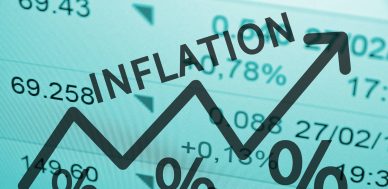Why Inflation Could Become a Problem for the U.S. Economy
Warning: early signs of inflation in the U.S. economy are starting to flash red. Don’t ignore this. Inflation could really get out of hand, and it could have dire consequences on the overall U.S. economy.
First, look at the official data. According to the Bureau of Labor Statistics, in the first 10 months of 2017, prices in the U.S. economy grew by 1.6%. In the entire year of 2016, inflation in the U.S. economy was two percent. (Source: “CPI-All Urban Consumers (Current Series),” Bureau of Labor Statistics, last accessed December 6, 2017.)
Price increases in the U.S. could very well turn out to be two percent in 2017 as well.
Looking at the two percent figure, one could say, “isn’t that the number what the Federal Reserve aims for?” Yes, but don’t get too fixated on this figure. Look beyond the headline economic data.
One Key Inflation Indicator Shouldn’t Be Ignored
One number that investors need to pay attention to is the velocity of money. This is essentially the count of how many times $1.00 is used. If the money is being used over and over again, it could mean inflation ahead.
With this said, look at the chart below of the velocity of money in the U.S. economy.
Source: “Velocity of MZM Money Stock,” Federal Reserve Bank of St. Louis, last accessed December 6, 2017.
Notice something interesting?
You see, since the third quarter of 2016, velocity of the money in the U.S. economy is flattening. It was in a continuous decline since 2011. Between the second and the third quarter of 2017, velocity of money in the U.S. economy actually increased.
At its core, this is saying that money in the U.S. economy could be “picking up some speed.” This could mean soaring inflation ahead. In 2010, the velocity of money increased, and the following year, we saw prices soaring three percent in the U.S.
Money Supply Has Soared Immensely
Over the years, the money supply in the U.S. has soared. Look at another chart below to get some perspective.
Source: “MZM Money Stock,” Federal Reserve Bank of St. Louis, last accessed December 6, 2017.
As the U.S. economy was recovering from the financial crisis, the money supply was around $9.50 trillion. Now, it’s $15.16 trillion. This represents an increase of close to 60%.
This time around, you won’t need velocity of money to go up much. A small increase could result in significantly higher prices.
What’s Ahead for the U.S. Economy?
Looking at all this, don’t rule out a period of high inflation in the U.S. economy ahead just yet.
As a result of low-interest rates and quantitative easing, we have seen massive monetary inflation (money supply has increased immensely). Will it start to show up in prices? Its very possible now more than ever.
With all this said, let me make it very clear: if prices rise in the U.S., it could cause a massive damage to consumption. Don’t forget, it amounts to roughly 70% of the U.S. gross domestic product. With soaring inflation, we could all of a sudden have a tumbling U.S. economy.
